The premise is simple: read one comic every day for the entire year. It seems like a simple task but there is no way that I read 365 comics last year, even if you count the individual issues in collections. So, this year, I am committing myself to this reading challenge, in the hope that I can broaden my reading habits and fully engage with my favorite hobby again.
Get the Danny Elfman soundtrack on and the face prosthetics ready because it’s Dick Tracy week.
Starting as a newspaper strip in 1931, Dick Tracy, created by Chester Gould, soon became a success with spin-off radio shows, movie serials, comic books, and a plethora of merchandise. The tough detective fought a range of crimes with the same no-nonsense adherence to justice, even if his methods were occasionally brutal and single minded. The strip represented Gould’s beliefs and was a reflection of his own tough stance on crime. It employed real police procedures and a few science fiction elements that were only just ahead of their time.
The 1930’s was a fairly steady time for Dick Tracy as Gould built up his world and packed it with interesting supporting characters. Most of the criminals came and went, nothing more than fuel to move the story forward, and not many of them were particularly memorable. But then came the 1940’s and Gould introduced a series of villains who could match any superheroes rogues gallery while still maintaining an element of realism. The grotesques, as they came to be known, were characters whose physical appearance reflected their internal criminal intentions. The comic strip shot from being a good police soap opera to a magnificent crime adventure.
For most of this week I will be reading from volumes 7 and 8 of IDW’s The Complete Dick Tracy. IDW published a series of treasury books that reprinted all of Gould’s original comic strips from 1931 up to 1977 when he retired from the strip. With volume 7, I am starting at the beginning of the rise in quality and adventure.

Comic Number 36: July 13, 1941 to September 16, 1941
Not all Dick Tracy stories start with a crime, but there is usually a crime just around the corner. In this instance, the narrative picks up with Tracy on his way to the hospital for a check-up, but the journey is interrupted by a runaway tram. The trolley car, out of control, takes a bend too fast and crashes into a building. Upon investigation, Tracy and Pat discover that the driver has been shot.
And so begins the story of Littleface Finney. Like a number of the criminals in a Dick Tracy strip, Littleface doesn’t have much of a backstory, and it’s the present day that matters most. When the reader is first introduced to Littleface, he is shown reprimanding member’s of his gang. In a cruel punishment, which turns to ironic justice for the crime boss, Littleface sets one of his gang members on fire. What follows is a classic hide and seek story, a format that Chester Gould employed time and time again. What makes the format exciting is Gould’s imagination and ingenuity. In this storyline, Tracy is left dangling from a high rise building only to be rescued by a circus performer. Meanwhile Littleface is trapped by a cab driver and plunged into a river. He escapes upon being rescued, crashes another car, hides in a meat packing truck, and almost dies from frostbite. It’s a short but thrilling ride and demonstrates Gould’s ability to make a routine chase into something exciting and special.
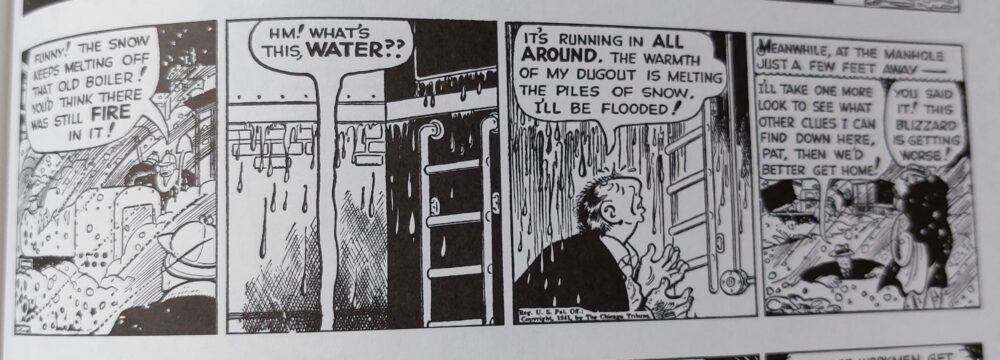
Comic Number 37: November 15, 1941 to December 24, 1941
Deep underground, hidden like a Fantastic Four villain, lives the Mole. He hides criminals on the run and takes all of their money. He has very few scruples, however, he really hates backstabbers, as petty crook Duke discovers when he tries to make a run for it early in this story.
The Mole is a classic Gould villain with features and habits that are more animalistic than human. But while the brute force of evil is at work below the streets, Tracy is above ground demonstrating another aspect of Gould’s superb storytelling techniques: police procedures. While it is easy to remember the violence inherent in the Dick Tracy strips, especially in these early stories, there is also clear attention given to police investigation. After the strangled body of Duke has been found, the police force are shown taking fingerprints, analyzing samples of mud, and cross referencing data bases. Dick Tracy is a real investigator and Gould enjoys this aspect of the storytelling as much as the criminal activities and the violence.
This story arc also demonstrates another of Gould’s strengths: his rendering of weather and environmental elements. Halfway through the story, there is a snow storm which in turn leads to the flooding of Mole’s underground lair. Gould captures the biting, wind chilled snow storm beautifully, creating an environmental contrast between the warm interiors and the freezing exteriors. He also gives the flood water such energy that it becomes a force of nature and a real danger, at first for Mole and then for Tracy.
Despite only having a small number of panels to play with each day, Gould is able to create encompassing environments that set the scene visually and atmospherically. Throughout the years his draftsmanship often overtakes his storytelling to become the most compelling aspect of his work.
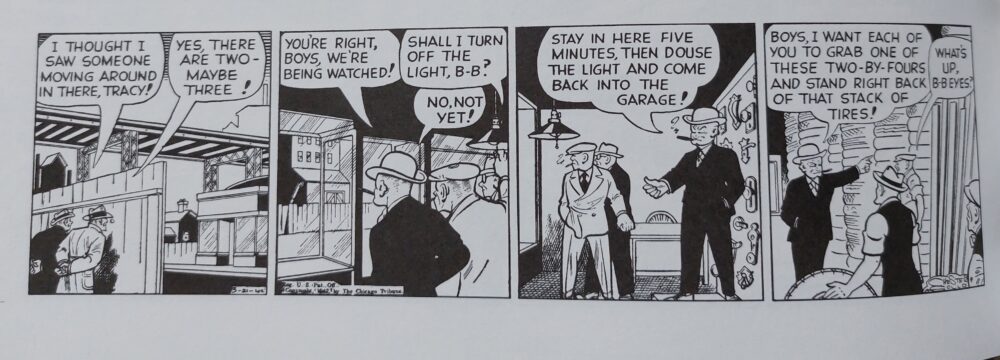
Comic Number 38: February 3, 1942 to April 18, 1942
The saga of BB Eyes is a story in two acts. Act one is a revenge driven tale where the villainous gangster kidnaps and attempts to kill Dick Tracy and Debby Thorndike, a socialite BB blames for the death of his brother. When the murder attempt goes south, BB returns to his gang of illegal tire thieves.
The first act is packed with comedic moments, something lacking from the previous stories I’ve read this week. Gould peppered his scripts with humor and comic relief, especially with some of the supporting characters, so it’s not a surprise to find it here. Tracy’s contempt for the socialite Thorndike is brilliantly witty, but it also allows for some growth in the character as the detective and the club owner have to struggle together to survive. It’s a proper odd couple moment.
As we move into the second act the humor falls away as the viciousness of BB Eyes takes center stage. He kills a policeman as a warning to Tracy and risks the lives of his gang just to get a little payback. He is cruel and heartless, just like the type of criminal that would feature in the newspapers where this strip first appeared. Due to the collective nature of these books, a lot of the paratext associated with the strips is lost. We don’t know what was front page news the day that BB Eyes’ demise was published, however the IDW collections do contain several fascinating essays that touch upon both Gould’s life and the society surrounding the stories publications.

Comic Number 39: November 1, 1942 to February 3, 1943
The introduction of Boche, better known as Pruneface, demonstrates Gould’s love of the grotesque but it also shows how the creator had his finger on the societal pulse. By the end of 1942, the Second World War had been raging for over 3 years, and American Comics were doing their part to spread anti-Axis propaganda. Pruneface, and his immediate superior Number 20, were agents of the Axis powers and embedded in America to sabotage the war effort. But neither of them had reckoned with the daring American people.
There is a patriotic feel to this story arc, and everyone pulls together to capture and fight the enemy on home soil. But, at the same time, there is an affiliation with the villain. As readers, we don’t agree with their actions, but we enjoy their character as much as the straitlaced Tracy and his police pals. In one of the opening essays to Volume 8, Max Allan Collins notes that ‘the character designs [..] are so striking, so compelling, that our conscienceless eyes fall in love with them.’ Comic fans love a good villain; in fact the most popular superhero comics rely on their great rogues gallery for their popularity. And Dick Tracy has one of the best rogues galleries in comic history.
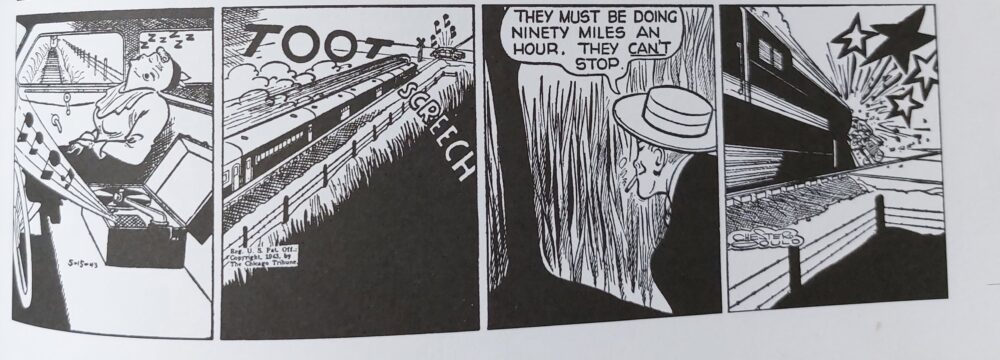
Comic Number 40: April 15, 1943 to July 12, 1943
Dick Tracy once more removes himself from the hospital and stops for a steak on the way home. Unbeknownst to him, within that very building a murder is being planned, and so begins the story of 88 Keyes.
I have a soft spot for this villain because of Mandy Patinkin’s portrayal of him in the 1990 movie where he’s not so villainous and more of a man out of his depth. He tries his best to impress both the father figure in Big Boy, and the beautiful woman Breathless Mahoney.
The 1943 story, however, is more violent, nasty, and moralistically dubious. It also contains some racist caricatures that are difficult to overlook. As Marc Singer has noted, ‘Comics rely upon visually codified representations in which characters are continually reduced to their appearances’ (from his article ‘Black Sins’ and White Masks’, published in African American Review Vol 36 No 1). This reductionism has often created images and characters that are unacceptable by later generations. There are several examples of it in Gould’s comic strip throughout the early years and, unfortunately, the example in this story does make this arc problematic. A number of essays have been devoted to racial representation in comics, and Marc Singer’s article is a good place to start.
Another problematic element of this story is the way in which Tracy heartlessly, and matter-of-factly, dispenses with the villain. He finds out where 88 Keyes is hiding and without negotiation, riddles the hiding spot with bullets from a machine gun. Afterwards, as Tracy explains to Pat how he knew where 88 Keyes was hiding, he says that the pianist wasn’t going to come peacefully but in the previous days strip, that isn’t illustrated. There is just the cold hearted, brutal murder. Maybe the following story, and the treatment Tracy receives in the hands of Mrs Pruneface, is a recompense for the detective’s actions here.
All in all, the problems with this story arc manage to overshadow the story itself. If you were only exposed to this continuity you would be left with a poor impression of Gould’s ongoing strip.
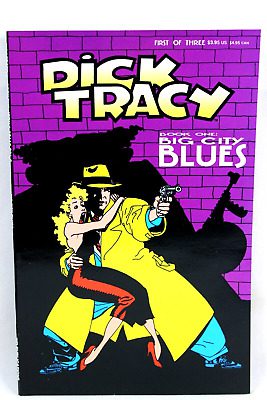
Comic Number 41: True Hearts and Tommy Guns (issues 1 and 2)
In 1990 Disney issued a three-part miniseries called True Hearts and Tommy Guns to tie in with the release of Warren Beatty’s movie adaptation. The series was drawn by Kyle Baker and is, without question, one of the most visually exciting versions of Dick Tracy you are likely to see. The artwork across the three issues is sublime. It is modernist in approach and draws on the grittiness of the original comic strip and merges this with the visual flair of the movie.
Issues one and two, Big City Blues and Vs The Underworld, are two of the comics I have read the most over the years. It is part origin story, part prequel, and includes all of the villains I have been reading this week, plus a whole bunch more, including Flattop, Big Boy, and Lips Manlis. All of the characters from the film are here along with some of Gould’s other greatest villains, such as the Mole.
Even if you ignore the actual narrative and aren’t a fan of Dick Tracy, or crime comics in general, you will still get a kick out of the art in this miniseries.
Have I used the word ‘Outstanding’ yet?
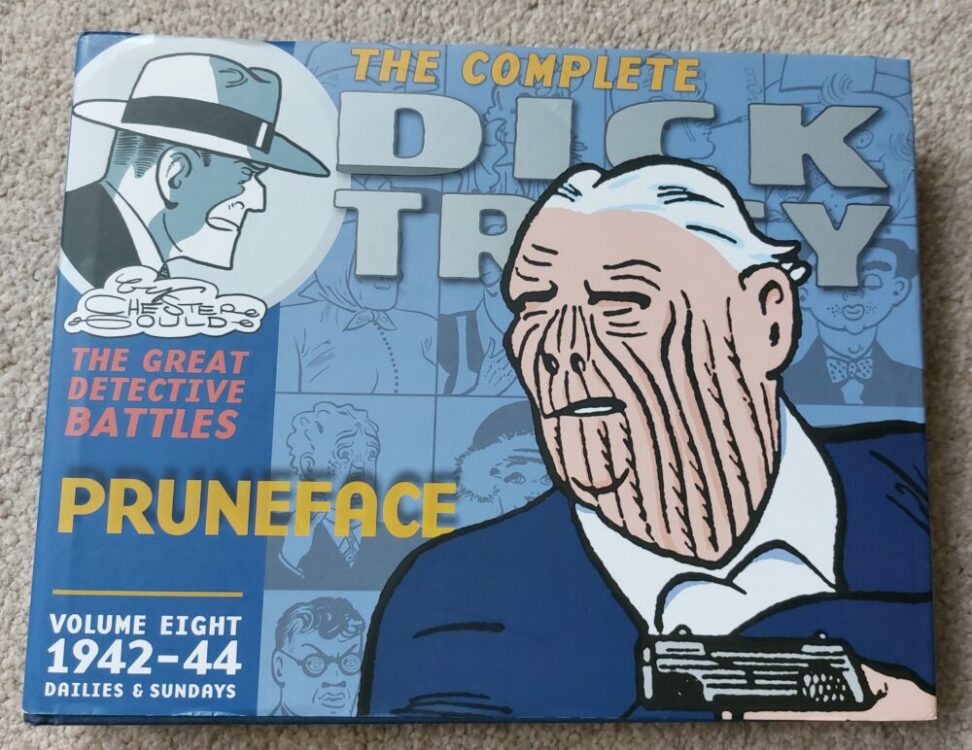
Okay, I will probably start a discussion with my final “comic” choice this week. In fact, some may argue that it’s not a comic at all. However, there are Comic Books, which are what most people read and are dominated by superheroes in the American Market; there are comic strips, which appear largely in newspapers and online; then there are Comics, a medium that is transcending the printed page and starting to become something more. Since the first comic characters, there has been multimedia tie-ins and merchandising. It is not something new that Marvel has created with their Marvel Cinematic Universe. In fact Dick Tracy has had radio serials and movie serials since 1934, starting less than 3 years after the strip first appeared. Therefore, my final ‘reading’ this week is..
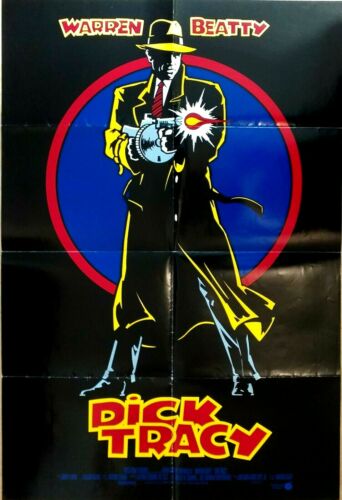
Comic (movie) Number 42: Dick Tracy (Beatty, 1990)
“But a film isn’t a comic!” I hear you cry. And I agree with you, however, the Dick Tracy movie is arguably the best comic book movie ever made. It is one of the few movie adaptations that takes on the structures and constraints of the comic strip to create something that is as close to a comic as possible, but on film. All of the DC and Marvel films attempt to translate the source material to a new medium, but Warren Beatty wanted to adapt the visual nature of the comic strip for the screen, not just re-interpret the characters in a new medium. Producing something that looked and felt like a comic was Beatty’s intention from day one, and the final product is a masterpiece of media adaptation.
Michael Cohen wrote about Beatty’s version of Dick Tracy in the book Film and Comics. He noted that the movie was “the most meticulous effort to capture the aesthetic of a comic in a live-action film.” Beatty used static cameras to create the sense of a ‘panel’ within the film. The mise-en-scene involved creating an overall scene setting shot followed by distinctive empty backgrounds and limited props to focus primarily on the characters. This is a technique that comic artists use all of the time and is a contrast to the usual approach to mainstream film making. Drew Morton explained that “Beatty and his production team graphically remediated the iconographic minimalism of Gould’s compositions and the limited color palette the writer/artist was bound to” (taken from his 2017 book Panel to the Screen : Style, American Film, and Comic Books During the Blockbuster Era). The use of reductive yet instantly recognizable scenery had become commonplace in the comic strip but was actually something new in Cinema and this avantgarde approach led to the mixed reactions that the movie’s release received.
The film has no pretensions of reality, it is aiming to be a comic book movie in the truest sense, even down to the framing of the shots and the reproduction of color. It is an example of hyper-realism, something even most superhero films try to avoid, and it adapts the language and aesthetics of comic strips more so than 99% of other ‘comic book’ films.
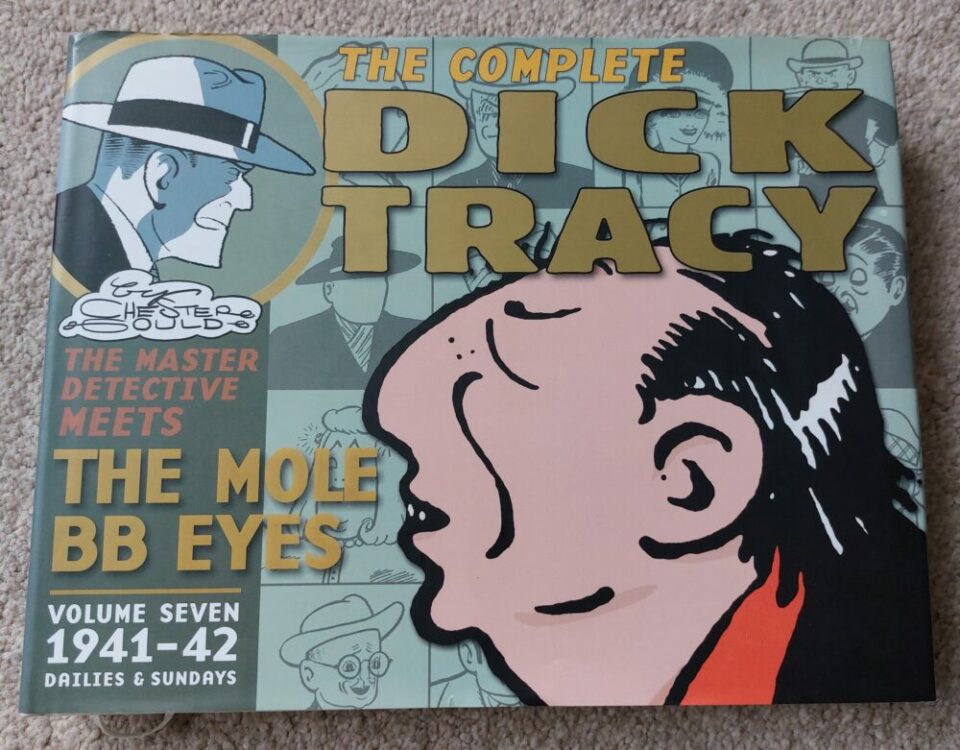
There is so much to discover in comic strips, and in the space of two years, Chester Gould’s Dick Tracy has a lot to offer its readers, but also historians and those wishing to study comics. Excitement and adventure sit side by side with social propaganda and questionable representations. Morality is at the heart of much of Gould’s work or, as Linda A Mooney and Carla-Marie Fewell put in their essay Crime in one long-lived Comic Strip, “The continued theme of the cartoonist, Chester Gould, was a ‘morality play’ i.e. the triumph of good over evil.”
I would recommend the collected editions from IDW Publishing if you want to learn more about Dick Tracy, because not only do they include the uninterrupted run of strips, but they also contain some wonderful essays about the creator and his creation. The books, however, are not easy to come by.
Coulton Waugh describes the work of Gould best in his book The Comics: “There is a gruesome intimacy here which is perhaps only possible in such a frank medium as these innocent-looking little funny sheets.”
And when all is said and done, in the worlds of Dick Tracy and his creator, Chester Gould, Crime does not pay.

